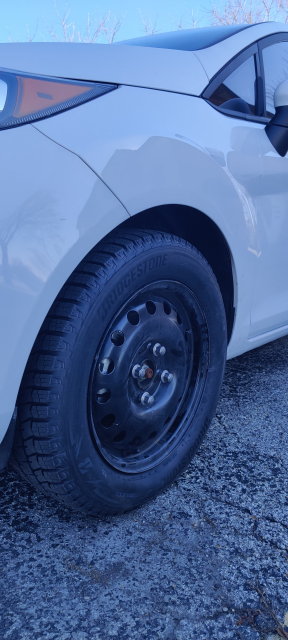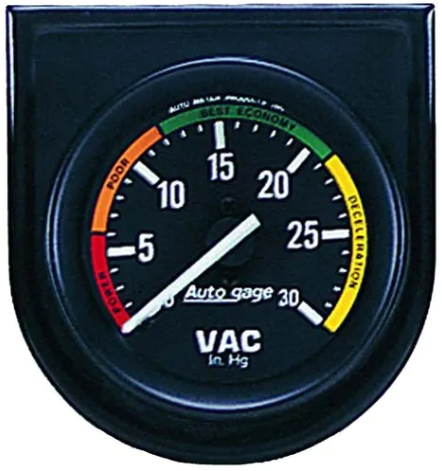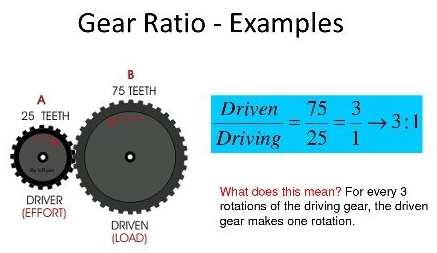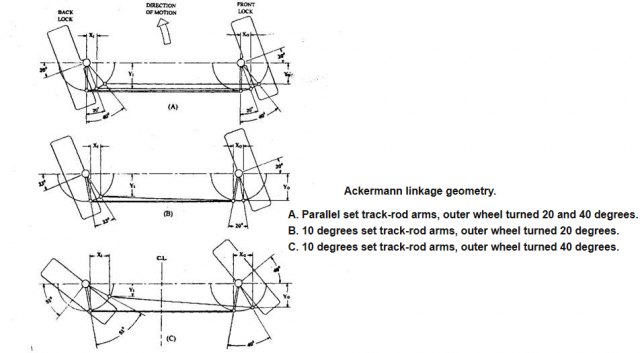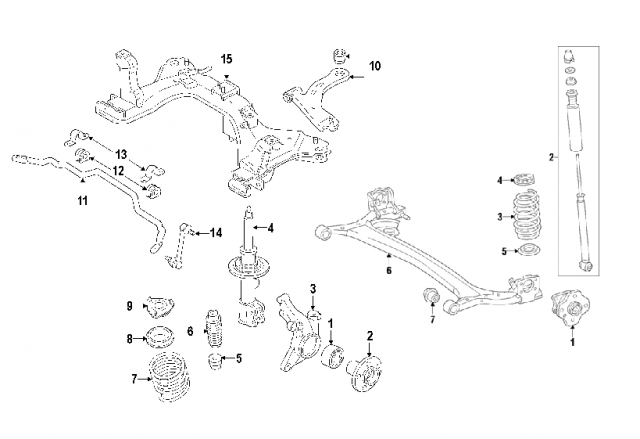-
Sign Up! To view all forums and unlock additional cool features
Welcome to the #1 Ford Fiesta Forum and Ford Fiesta community dedicated to Ford Fiesta owners and enthusiasts. Register for an account, it's free and it's easy, so don't hesitate to join the Ford Fiesta Forum today!
Tire size
- Thread starter Thegrassman
- Start date
- Messages
- 1,976
- Likes
- 1,384
- City
- Grand Rapids
- State
- MI
- Country
- United States
- What I Drive
- 2018 Ford Fiesta SE HB
IN a basic sense, the concept is good, but you won't know how the effect plays out unless you do some initial math with the diameters of the old tires, then install the new ones (or do a side by side single tire by tire comparison) to see any true differences in distance traveled.
Since you're going to a larger diameter - you obtain distance - but lose torque - to keep speed.
There is also the issue of Overdrive - where the wheel can spin faster than the engines output.
In this instance, you're changing the tire SIZE which doesn't increase the RPM for the Gear you're in, just the distance your car travels in using that same RPM to do so.
So if you wish to drive using 60-series sidewall but use 15" 50 series tires - upgrading to 60 series will affect the distance per turn of the tire. The sidewall is 10% more area - which means it "sits" in a taller profile, and that means that taller profile and Pi (π - as the Circumference of tire) comes into play as the extra distance the tire can roll to complete 1 revolution of turn
You'll travel farther - but it will take more energy to complete the turn.
Hey, I learned too.
I just wish the GEARBOX, both the gear selection and the Differential gear paring was a little more towards gaining speed in the lower gears.
The main premise is, right now, our differential gearboxes are 4.15 gear - they used to have a 3.82 gear for their V6 and above (in CID) for the conversion of power into torque and rotation meaning speed and acceleration.
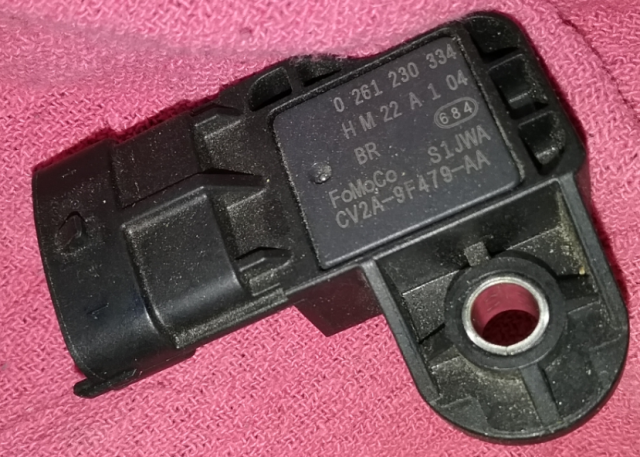
Your new "Vacuum Gauge"
a sensor that sees vacuum as a pressure in a varying electrical signal
that the cars Ignition system can process and perform accordingly.
Ok, what do I mean by 4.15 versus 3.82?
Well, easy enough to simply look at the Pinion and Ring gear of the Differential - how many turns of the pinion has to make before it completes 1 full turn of the ring gear? (Think that the Smaller Gear - is your driver gear, the one that comes from the Engines Crankshaft - The Driven Gear, is the "tire" or your Output side - which is larger and has more of the teeth to engage that Driver (Engine side) gear)
The more turns of the 4.15 Pinion, means more torque but you loose speed because that pinion- being smaller, turns more frequently than using the 3.82 method. The 3.82 Pinion turns 0.33 less revolution (compared to the 4.15) of turn to make the ring gear turn once.
That equates to less RPM is needed to make the Differential make that one turn - but again, a loss of torque to obtain the distance in turn affects the speed - you'll go faster for more distance (at that level of RPM) - but less torque is made available to make the speed - which that means to keep the speed, you'll have to apply more power thru the engine to keep the RPM up.
So when you look at the Tire size issue, then the tire you have, is one given size which completes a given distance per turn.
The tires you want, are LARGER - which will let you travel slightly farther, but will take more effort by the engine to complete that task.
So to help with a lesson I learned - I had to go back to the OEM size and live with it for now while the XYL is kept happy and when pothole season is over - I'll be looking for a different size tire - for 15" rims being that I'd live with a 185/65 series tire than to try and keep the wider 195 - and go up from the 50% sidewall to 65% sidewall of a smaller width tire to find better equilibrium
Partly due to width of Rim, (OEM is 6.5") which other Rim I would LIKE to use is 6".
To some this may seem I'm going backwards, I'm really not. The key word here is POTHOLE - a higher sidewall gives the car a level of height above the road that the rubber of the sidewall can absorb more of the shock of the rough road better and survive than to keep a thinner (Read: Tires' less height from the Road surface equates to Wheel Rim is closer to the road surface) sidewall and suffer bent rims and potential undercarriage damages from rough road and lack of clearance.
Since you're going to a larger diameter - you obtain distance - but lose torque - to keep speed.
There is also the issue of Overdrive - where the wheel can spin faster than the engines output.
In this instance, you're changing the tire SIZE which doesn't increase the RPM for the Gear you're in, just the distance your car travels in using that same RPM to do so.
So if you wish to drive using 60-series sidewall but use 15" 50 series tires - upgrading to 60 series will affect the distance per turn of the tire. The sidewall is 10% more area - which means it "sits" in a taller profile, and that means that taller profile and Pi (π - as the Circumference of tire) comes into play as the extra distance the tire can roll to complete 1 revolution of turn
You'll travel farther - but it will take more energy to complete the turn.
Hey, I learned too.
I just wish the GEARBOX, both the gear selection and the Differential gear paring was a little more towards gaining speed in the lower gears.
The main premise is, right now, our differential gearboxes are 4.15 gear - they used to have a 3.82 gear for their V6 and above (in CID) for the conversion of power into torque and rotation meaning speed and acceleration.
- Read the above statement as a Conversion of a gear size to another - in earlier times the Low-End Torque available for use was greater in larger CID motors. So the conversion efficiency of Larger gear versus Smaller gear at a gear set that was more for low-end torque "launches" is different. The Low-end gears of say 1st thru 3rd - kept the RPM to speed conversion better for lower gear and high torque (the Driveshaft to Engine Crankshaft rotation multiplier) - while when the higher gears were used, that low-end torque of the motors displacement offset a loss in the actual conversion to speed for those higher ratio (or closer gear ratio of Crankshaft to Driveshaft) rotational RPM.
- This is why the effort of using bigger (or larger diameter) tires tends to sway the buyer into thinking that this larger tire is the way to go - I wish it was, but it's not. The real conversion efficiency is in the amount of throttle needed to make that car go in any given gear.
- In earlier times - one main piece of gear that people began to use was Vacuum gauge to help determine the load to the level of efficiency (throttle used) - and one way to determine this was by using a Vacuum gauge to help tech you how to set your speed and throttle use by observing how much the engine worked - by monitoring the level of vacuum - the air below the throttle plate getting put into the cylinder - as a means of showing you how much throttle and effort the engine did - in inches of Mercury - or vacuum.
- The basic idea behind this tool was simple. Drive the vehicle normally and observe the needles position as you can do so safely and note readings and their changes as you apply throttle, reduce throttle - coast and rest at idle.
- The needle shows the ranges of Power (RED) and Poor performance (POOR) while Best Economy was where you should keep the needle by modulating or the pressure you applied to the throttle - for best "carburetion and fuel economy".
- The above also told you how much wear and tear was on the vehicle and if it was in need of a tune up or timing adjustments by reviewing how the needle acted when in different driving and idle conditions.
- In more current times, Fuel Injection and MAP systems - they are the new way the system is monitored and adjusted for best Emissions - you simply apply the throttle and the vehicle simply "tunes" the system to perform - maybe not by what you expected, but for best Emissions and Fuel Economy for the Power you're demanding from the system, it can deliver.

Your new "Vacuum Gauge"
a sensor that sees vacuum as a pressure in a varying electrical signal
that the cars Ignition system can process and perform accordingly.
Ok, what do I mean by 4.15 versus 3.82?
Well, easy enough to simply look at the Pinion and Ring gear of the Differential - how many turns of the pinion has to make before it completes 1 full turn of the ring gear? (Think that the Smaller Gear - is your driver gear, the one that comes from the Engines Crankshaft - The Driven Gear, is the "tire" or your Output side - which is larger and has more of the teeth to engage that Driver (Engine side) gear)
The more turns of the 4.15 Pinion, means more torque but you loose speed because that pinion- being smaller, turns more frequently than using the 3.82 method. The 3.82 Pinion turns 0.33 less revolution (compared to the 4.15) of turn to make the ring gear turn once.
That equates to less RPM is needed to make the Differential make that one turn - but again, a loss of torque to obtain the distance in turn affects the speed - you'll go faster for more distance (at that level of RPM) - but less torque is made available to make the speed - which that means to keep the speed, you'll have to apply more power thru the engine to keep the RPM up.
So when you look at the Tire size issue, then the tire you have, is one given size which completes a given distance per turn.
The tires you want, are LARGER - which will let you travel slightly farther, but will take more effort by the engine to complete that task.
So to help with a lesson I learned - I had to go back to the OEM size and live with it for now while the XYL is kept happy and when pothole season is over - I'll be looking for a different size tire - for 15" rims being that I'd live with a 185/65 series tire than to try and keep the wider 195 - and go up from the 50% sidewall to 65% sidewall of a smaller width tire to find better equilibrium
Partly due to width of Rim, (OEM is 6.5") which other Rim I would LIKE to use is 6".
To some this may seem I'm going backwards, I'm really not. The key word here is POTHOLE - a higher sidewall gives the car a level of height above the road that the rubber of the sidewall can absorb more of the shock of the rough road better and survive than to keep a thinner (Read: Tires' less height from the Road surface equates to Wheel Rim is closer to the road surface) sidewall and suffer bent rims and potential undercarriage damages from rough road and lack of clearance.
Last edited:
- Messages
- 1,976
- Likes
- 1,384
- City
- Grand Rapids
- State
- MI
- Country
- United States
- What I Drive
- 2018 Ford Fiesta SE HB
To help further...
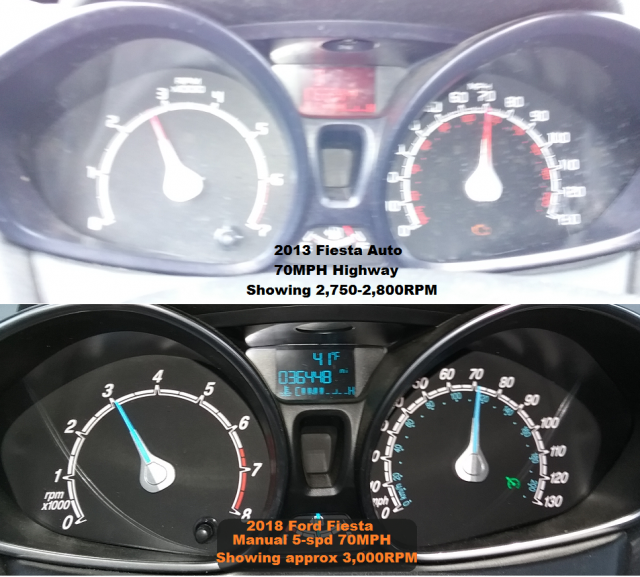
(apologies for that shaky photo - but while driving an older car - some suspension issues are always evident - and in light of these posts - also demonstrates the performance level of long term damages rough roads and tire wear can present to the driver trying to keep their car serviceable for longer periods of time)
This is an un-calibrated and certainly not side by side comparisons, but it does demonstrate the ability for the Automatic when on the highway, in lockup (read as no converter or other forms of loss)can be driven at highway speeds in lower RPM range. Not by much, but it does show that with the P195/60/R15 compared to the OEM of the vehicle I have which are P195/50/R16 of a 5-speed stick --- there is a small (albeit less than 10% change - or your 0.33 difference) gain obtained - but at the price of the higher speed and the conditions you have to travel at to gain that advantage.
Ford lets the Auto win in MPG but only as the benefit from the gearing associated with what we discussed earlier.
The RPM change is relatively small - but in fuel savings versus the raising the tire size to obtain that figure of merit...
So to keep the MPG up, we have to use a different set of rules - keeping an eye more on road resistance and loading.
Use a narrower tire (tread width - usually 1 size down e.g-195 use 185) then go up a 10% rate of sidewall like from 60 series to 65 or even 70 - with the reminder that when you reduce the width of the tire - the sidewall height also is reduced in proportion to what is written on the sidewall. Means that you need to keep in mind that tire height is just as important as the width of tire.
Ok, here's a cool site I think might help you. However, read and understand the data carefully - this site and the data it holds, can look confusing for many people not familiar with tire sizing and the overall effects of diameter changes. When you change size, this affects the number of turns a tire makes in a mile - which is your final result. It can show you how gearing affects your size selected - you can't change the transmissions gearing - but changing the tire size - you change the number of revolutions in that distance that the tire travels - to make that mile.
To help, the FORD(2018)Fiesta OEM tire size for it's spare tire is T125/80/R15 (at least for mine - check yours it may vary)
Gives you a TIRE DIAMETER of 22.9 inches...
The FORD Fiesta using a 195/50/16 tire size ...
Gives you a TIRE DIAMETER of 23.7 inches...
Or nearly a inch higher - (equals 1/2 inch in rise from the floor or it's lift, to the rim/center of tire) already....
While the one in the above photo demo of the Automatic - that tire size is a P195/60/R15
Gives you a TIRE DIAMETER of 24.2 inches...
(...Which equates to an overall change in height from the SPARE TIRE size that fits the wheelwell in the trunk, of nearly 1.3" inches of height change - which when you look at height from road surface - that lift is only barely 5/8" inch in height...)
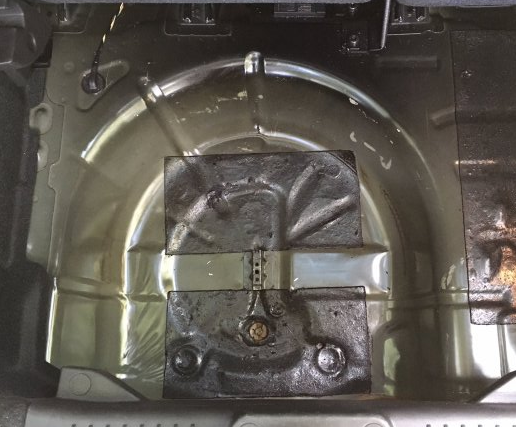
If you want some simple advice...
Whether you do the 5-way tire rotation or just use 4-way tire rotation for even tire wear...
Best to get, use, or otherwise switch, to a tire size that fits what you will continue to use,
- or will need to use, when you decide to change to a new tire rim and size combo.
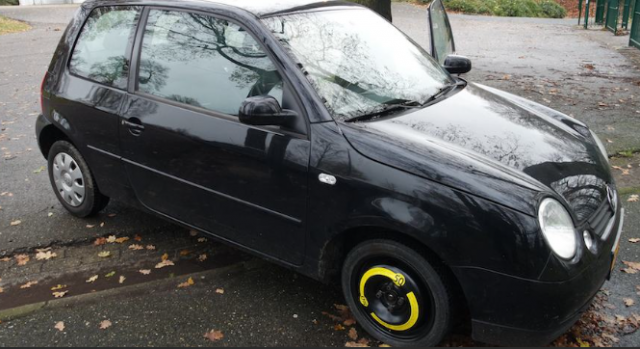
Make sure it fits the wheel well that the spare came in
- else you'll be looking for a way to store that tire that needs repair in a spot it won't fit.
This becomes an issue when you're travelling or on the road and need to fix
a flat tire in an emergency with your spare.
IF you use the wrong sizes - your broken tire may not fit in the space the spare came out of.
Having the tire wide enough to bear the load - is a trade off to road resistance. So the WIDER the tire - the more rubber and load it can bear (to a point) but the road resistance issue is a beast that does come to bear on the tire, it's ability to roll and how long it will last (tread wear).
So although I don't recommend everyone do this, this might help you develop a feel of when a vehicle loses power - how will you steer the car when it's ability to power the steering - goes out?
Remove your little red cover on your Battery...
See EPAS wire - (disconnect the Ground cable first - you'll need to reset any codes when you do this) - remove the nut and pull the cable off the stud.
Now reattach the ground cable - and start the car and drive it slowly - you will feel the steering wheel is hard to turn - it may even turn to the left or right on its own.
This helps demonstrate the geometry of the steering and suspension - if everything is correct, you would not sense or feel any pull on the steering wheel in any given direction as you travel. Same applies to the braking and steering "throw" or rate of turn both Left or Right.
When you use wide tires (wider than stock) or a Rim with no offset (one that sticks out) you will encounter a force in the wheel where the car wants to go in a direction to stay stable - which may not be straight ahead - it may drift left or right and every time you try to correct the wheel, it steers itself back to the specific orientation and geometry.
Yes, this is a leaning (er, Learning) experience for you - you are now experiencing how Drive By Wire (DBW) steering works in keeping your car on the road.
Sure - it's a bit hard to turn on hard pavement when you're stopped, but when you begin to roll you'll find the level of effort (your torque) is less - because the tire rolls and is flexible to let the pavement force it sees - get distributed on a rolling tire contact point.
Ok, now undo that - Disconnect ground - reconnect the EPAS cable - reconnect Ground - you're ok...
When someone wants to try a different tire size, have them remove the power steering "ability" for the system to turn the tires. Then just try to drive the car with your STOCK wheels - having such an experience you will be able to tell them why you know why.
When you go a tire size wider (your first number) - it a LOT harder to steer - to a point where you can't do it safely - but ever try a narrower width tire? It's a lot easier. This is an important lesson - when it comes to life of bearings and rolling resistance and Alignments - all are extremely important to have your ducks in a row when it comes down to tire and suspension maintenance.
Any bad alignment's show up in the steering wheels ability to stay straight when the DBW (Drive By Wire) is disabled for the EPAS - hey, you need to learn this for the newer EV's themselves are already looking into ways of extending life of the system and charge by doing such things like what I'm trying to teach here...reduce your load and rolling resistance - you can go farther on that tank of gas....
Again, many little things that are added to provide safety and longer service life, also add weight.
You think things are bad with extra parts and all their support structure and the required maintenance...
The EV Market is suffering a similar issue of how to carry all the power you need to travel, safely - and not tear up the roads we still have to roll them along on...
Go look for Curb weight search on the Fiesta...
It's about 2,600 lbs - so yeah, it's hefty...
But ever "weigh" a EV vehicle?
Try Tesla...Roadster...their first models...2,700 for starters, and it was a two seater...
Ok, Range?
Fiesta - averaging 35MPG - approximately 430 miles...
Tesla? (Brace yourself - this is their claim) - 620 miles!
44% difference in travel distance, But you'll need to find a charging station for that Roadster. And time...
What about the Fiesta?
Well, remember were comparing an EV sport car to a family commuter - so in fairness' we can bring along a 5 gallon gas can as a refill for part of the storage - not recommended - but - when you face an mandatory evacuation - your chances of getting out of there fare better in a gas-powered vehicle than an electric power one at this current state of readiness we have.
So in fewer words...
Keep less junk in your trunk and keep the tire size within a reasonable diameter size - being around 23~24 inches to reduce problems in clearance and load - while focusing on proper alignment of all four tires and keeping them inflated to a correct pressure.
Using the mindset of proper tire diameters to have enough torque on the road to help you accelerate yet give the least rolling resistance - That works better than to try change tire sizes to attain a gear output ratio that equals an overdrive gear that would hurt the cars ability to maintain fuel economy and still be affordable to drive.
Again, the automatic only benefits when the RPM and speed are high - for long duration periods of time - meaning long trips at highway speeds, it can't compete well in city-stop-start traffic messes - where the manual can outperform against torque losses in the direct drive geometry of it's gearing.

(apologies for that shaky photo - but while driving an older car - some suspension issues are always evident - and in light of these posts - also demonstrates the performance level of long term damages rough roads and tire wear can present to the driver trying to keep their car serviceable for longer periods of time)
Ford lets the Auto win in MPG but only as the benefit from the gearing associated with what we discussed earlier.
The RPM change is relatively small - but in fuel savings versus the raising the tire size to obtain that figure of merit...
- Being to drive 70MPH at 2800 RPM
So to keep the MPG up, we have to use a different set of rules - keeping an eye more on road resistance and loading.
Use a narrower tire (tread width - usually 1 size down e.g-195 use 185) then go up a 10% rate of sidewall like from 60 series to 65 or even 70 - with the reminder that when you reduce the width of the tire - the sidewall height also is reduced in proportion to what is written on the sidewall. Means that you need to keep in mind that tire height is just as important as the width of tire.
Ok, here's a cool site I think might help you. However, read and understand the data carefully - this site and the data it holds, can look confusing for many people not familiar with tire sizing and the overall effects of diameter changes. When you change size, this affects the number of turns a tire makes in a mile - which is your final result. It can show you how gearing affects your size selected - you can't change the transmissions gearing - but changing the tire size - you change the number of revolutions in that distance that the tire travels - to make that mile.
Yes, by changing tire sizes, it can...
- Affect speed
- Odometer reading
- Fuel Economy
- Engine load (acceleration)
- Steering
- Braking distance
- Suspension and Alignment
To help, the FORD(2018)Fiesta OEM tire size for it's spare tire is T125/80/R15 (at least for mine - check yours it may vary)
Gives you a TIRE DIAMETER of 22.9 inches...
The FORD Fiesta using a 195/50/16 tire size ...
Gives you a TIRE DIAMETER of 23.7 inches...
Or nearly a inch higher - (equals 1/2 inch in rise from the floor or it's lift, to the rim/center of tire) already....
While the one in the above photo demo of the Automatic - that tire size is a P195/60/R15
Gives you a TIRE DIAMETER of 24.2 inches...
(...Which equates to an overall change in height from the SPARE TIRE size that fits the wheelwell in the trunk, of nearly 1.3" inches of height change - which when you look at height from road surface - that lift is only barely 5/8" inch in height...)

If you want some simple advice...
Whether you do the 5-way tire rotation or just use 4-way tire rotation for even tire wear...
Best to get, use, or otherwise switch, to a tire size that fits what you will continue to use,
- or will need to use, when you decide to change to a new tire rim and size combo.

Make sure it fits the wheel well that the spare came in
- else you'll be looking for a way to store that tire that needs repair in a spot it won't fit.
This becomes an issue when you're travelling or on the road and need to fix
a flat tire in an emergency with your spare.
IF you use the wrong sizes - your broken tire may not fit in the space the spare came out of.
Wrong tire sizes can also induce a steering pull or roll that makes the spare you got - forced to be on a wheel that you have to take a tire off of in order to keep the steering geometry correct so you can take it down the road to a service station.
What that means is - you may have to change TWO tires, as in TWO TIRE CHANGES, one to fix the one that went flat, and also move a tire you still have to fit that spot and use the spare to fit the one you had to move to keep it going straight down the road so you can get it off that road.
All that for one simple tire size change, can force you into a tiresome long time spent swapping tires just to get you back on the road if you don't use proper tire sizing.
.
This relates back to torque needed to overcome Road resistance - the friction the tires place on the road to roll - and the loading - or ability to handle the load the car places on that wheel which will change the weight distribution - or how much the tire can safely handle.Having the tire wide enough to bear the load - is a trade off to road resistance. So the WIDER the tire - the more rubber and load it can bear (to a point) but the road resistance issue is a beast that does come to bear on the tire, it's ability to roll and how long it will last (tread wear).
So although I don't recommend everyone do this, this might help you develop a feel of when a vehicle loses power - how will you steer the car when it's ability to power the steering - goes out?
Remove your little red cover on your Battery...
See EPAS wire - (disconnect the Ground cable first - you'll need to reset any codes when you do this) - remove the nut and pull the cable off the stud.
Now reattach the ground cable - and start the car and drive it slowly - you will feel the steering wheel is hard to turn - it may even turn to the left or right on its own.
This helps demonstrate the geometry of the steering and suspension - if everything is correct, you would not sense or feel any pull on the steering wheel in any given direction as you travel. Same applies to the braking and steering "throw" or rate of turn both Left or Right.
When you use wide tires (wider than stock) or a Rim with no offset (one that sticks out) you will encounter a force in the wheel where the car wants to go in a direction to stay stable - which may not be straight ahead - it may drift left or right and every time you try to correct the wheel, it steers itself back to the specific orientation and geometry.
Yes, this is a leaning (er, Learning) experience for you - you are now experiencing how Drive By Wire (DBW) steering works in keeping your car on the road.
Sure - it's a bit hard to turn on hard pavement when you're stopped, but when you begin to roll you'll find the level of effort (your torque) is less - because the tire rolls and is flexible to let the pavement force it sees - get distributed on a rolling tire contact point.
This type of test may also help you discover alignment and suspension problems that DBW or even the power steering hydraulic pump in older used car - the level of wear in the suspension can have during a test drive.
You can see how it can mask errors in the suspension and drivetrain and alignment in ordinary driving conditions.
Bad rims or rims with improper offset will force the steering wheel to re-center in a specific angle which may include a drift caused by the offset the rims cause - versus travelling in a direction caused by the actual steering thrust the vehicle tries to follow, in the direction it wants to be in. (This type of problem usually means they may have reset the geometry to offset the thrust angle drift from the rim offset. A Negative Rim offset magnifies the condition when the steering wheel and the Toe-In-Toe-out and Caster Camber angles are no longer factory spec - they masked the drift by forcing the wheel to drift in the other direction to offset that error)
A good example of how to approach this is to think of this as the Ackermann principle.
The Ackerman principle looked at steering angle as a radius of a turn - with the distance to the radius center - being an imaginary point - so the steering angle geometry then took the inner tire as turning a tighter turn radius than the outer wheel - in this Rim Offset issue, this effect is magnified because of improper toe in and toe out which magnifies the drift and steering effort in a test such as this.
For in the (unfortunate) event - when that belt jumps or the electrical goes out - is when you feel the reasons why some may think wider tires are cool - might rethink that, when the motors finally fail from the extra effort they had to produce to fight against the effects improperly widened tread widths pose to a suspension system let alone the load they placed on the engine trying to power you around with tires that are way too wide to do you or your vehicle any good.
Ok, now undo that - Disconnect ground - reconnect the EPAS cable - reconnect Ground - you're ok...
When someone wants to try a different tire size, have them remove the power steering "ability" for the system to turn the tires. Then just try to drive the car with your STOCK wheels - having such an experience you will be able to tell them why you know why.
When you go a tire size wider (your first number) - it a LOT harder to steer - to a point where you can't do it safely - but ever try a narrower width tire? It's a lot easier. This is an important lesson - when it comes to life of bearings and rolling resistance and Alignments - all are extremely important to have your ducks in a row when it comes down to tire and suspension maintenance.
Any bad alignment's show up in the steering wheels ability to stay straight when the DBW (Drive By Wire) is disabled for the EPAS - hey, you need to learn this for the newer EV's themselves are already looking into ways of extending life of the system and charge by doing such things like what I'm trying to teach here...reduce your load and rolling resistance - you can go farther on that tank of gas....
Again, many little things that are added to provide safety and longer service life, also add weight.
You think things are bad with extra parts and all their support structure and the required maintenance...
The EV Market is suffering a similar issue of how to carry all the power you need to travel, safely - and not tear up the roads we still have to roll them along on...
Go look for Curb weight search on the Fiesta...
It's about 2,600 lbs - so yeah, it's hefty...
But ever "weigh" a EV vehicle?
Try Tesla...Roadster...their first models...2,700 for starters, and it was a two seater...
Ok, Range?
Fiesta - averaging 35MPG - approximately 430 miles...
Tesla? (Brace yourself - this is their claim) - 620 miles!
44% difference in travel distance, But you'll need to find a charging station for that Roadster. And time...
What about the Fiesta?
Well, remember were comparing an EV sport car to a family commuter - so in fairness' we can bring along a 5 gallon gas can as a refill for part of the storage - not recommended - but - when you face an mandatory evacuation - your chances of getting out of there fare better in a gas-powered vehicle than an electric power one at this current state of readiness we have.
On a crazy note, the Fiesta is "overburdened" when it comes to the suspension that most cars
use these days - a sway bar, links - even the control arms and the geometry seem to be more
than necessary, but then too, Ford was based out of Michigan - the Heart of the Rust belt
and used to be known for having two seasons, Sea-doos and Ski-doos...

Now, they are...

(for those that are new to Michigan... the above is POTHOLE SEASON and ROAD CONSTRUCTION)
Both go hand in hand...Ford learned too.
use these days - a sway bar, links - even the control arms and the geometry seem to be more
than necessary, but then too, Ford was based out of Michigan - the Heart of the Rust belt
and used to be known for having two seasons, Sea-doos and Ski-doos...

Now, they are...

(for those that are new to Michigan... the above is POTHOLE SEASON and ROAD CONSTRUCTION)
Both go hand in hand...Ford learned too.
So in fewer words...
Keep less junk in your trunk and keep the tire size within a reasonable diameter size - being around 23~24 inches to reduce problems in clearance and load - while focusing on proper alignment of all four tires and keeping them inflated to a correct pressure.
Using the mindset of proper tire diameters to have enough torque on the road to help you accelerate yet give the least rolling resistance - That works better than to try change tire sizes to attain a gear output ratio that equals an overdrive gear that would hurt the cars ability to maintain fuel economy and still be affordable to drive.
Again, the automatic only benefits when the RPM and speed are high - for long duration periods of time - meaning long trips at highway speeds, it can't compete well in city-stop-start traffic messes - where the manual can outperform against torque losses in the direct drive geometry of it's gearing.
Last edited:
Similar threads
-
Winter tires, what are people in the snow & ice belt running in 2024?...
- Started by scotman
- Replies: 12
-
-
-
4 Yokohama Avid Touring S 185-60-15 Tires Mounted on Steel Wheels With TPMS
- Started by Saving1manual
- Replies: 1
-
(Oregon) $300 Qty 4 Michelin X-Ice XI3 XL 185/60R-15 snow tires mounted and balanced on black steel wheels
- Started by QuesoEnFuego
- Replies: 2
-
ST Ebony OEM Wheels/Tires/TPMS, Full Set - only 3k miles - SOLD
- Started by Fordman
- Replies: 2
-
Blew Tire and now Dash Lights On
- Started by emccarthy
- Replies: 2
-
Fiesta Tires, 185 60 15, mounted on black steel wheels, w/ TPMS
- Started by Saving1manual
- Replies: 15
-
Replacement tire size question
- Started by HeatonJL
- Replies: 1
-
Wheel Size, Offset & Tire Information
- Started by Admin
- Replies: 48

